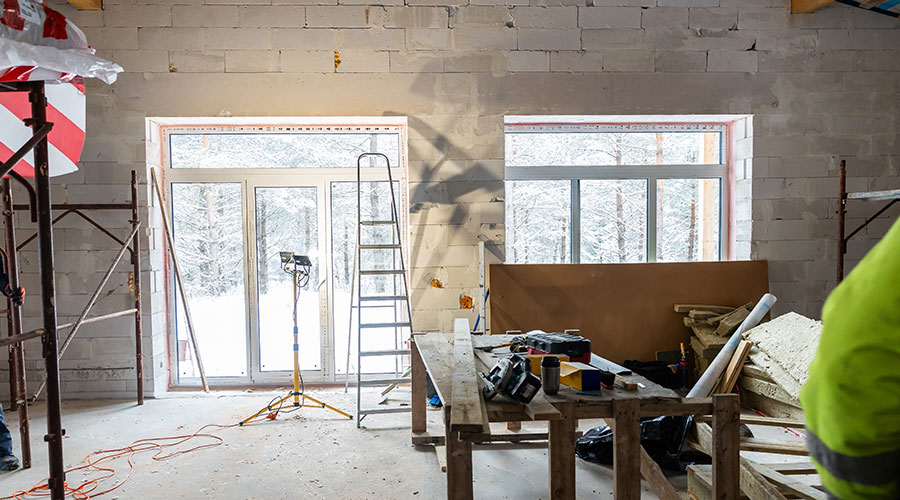A Look at Solar PV Roofing Options
Facility executives take advantage of technology innovations, third-party ownership, to move ahead with photovoltaic systems
Generating part or all of a facility’s electricity with photovoltaic (PV) systems is growing in popularity all over the United States. Whether the systems are used to lower peak demand costs, power an individual facility or enhance the green aspects of a project, even the smallest systems can help lower electric bills and clean up the environment.
Of course, upfront cost remains an issue. Most states, however, offer a range of incentive programs, many of which could take a PV system from the red to the black in as short a period as seven years. And as utility rates increase, payback periods shrink.
That doesn’t mean installing a PV system is a simple decision. There is still a lot of planning to do and considerations beyond cost to think about. The process can be further complicated as PVs continue to evolve with improved technology.
The following two case studies explore the range of possible choices — and challenges — that facility executives face. Cost was a concern in both, but other issues were equally, if not more, important.
A Nod to the New
For facility executives whose idea of a PV system dates back to the ‘70s — glossy blue tinted panels fastened to metal racks bolted to a roof — take note: New products are available that integrate PVs into the building, making them not only less obvious but also less risky.
Later this year, Steve Busel, facility director for Plainville Community Schools in Connecticut, will throw the switch on a 172-kilowatt system that will provide the district’s high school with 10.7 percent of its electricity, cut peak demand costs and help the community of Plainville reach its goal of getting 20 percent of its power from renewable sources.
Busel’s and the district’s interest in renewable energy coincided with a community task force charged with renovating some of the district’s schools, including the 250,000-square-foot high school. The task force decided it made sense to offer the community a way to cost-effectively incorporate PVs into the renovation program.
There were concerns about what type of PV system would be acceptable. Cost was an issue, despite generous state and utility rebates. The system also needed to fit the design and maintenance needs of the high school. For one thing, Busel wasn’t interested in poking holes in what was going to be a new roof. Plus the task force had some concerns about how the PVs would look and the possibility that any obvious installation would create an open invitation for vandalism.
After considering several different systems, Busel saw an opportunity to try something new in PV electric generation. He chose thin-film technology — flexible, 10-by-20-foot modules.
Thin-film PV does not have a rigid frame or solar cells. Instead, the material that generates electricity is layered onto a rubber-like substance. It’s as flexible as a roll of roofing and is rolled out onto the roof much like roofing. It attaches directly to the roof surface with adhesives so there are no roof penetrations. The system can’t be seen unless one is on the roof. The thin-film modules can be walked on, though regular traffic should be avoided. And they are more efficient under diffuse light than typical, rigid polycrystalline modules, something worth considering where winters can be cloudy.
“These panels are tough stuff,” Busel says. To test their durability, he walked on them, stomped on them and even whacked them with a hammer. They continued to produce electricity as specified.
The idea of using this new technology got a boost when state funds became available for installing a white PVC roof on the building. The PVC roof is exactly the substrate needed for the thin-film panels. The roofing supplier for the high school renovation has worked with the PV manufacturer in past projects, so the combination of roofing and PV modules has been tested. The thin-film array and new roof system cost $1.6 million more than a new rubber roof alone, which is what Busel would have specified. The PV array takes up about 40 to 50 percent of the roof surface.
Thin-film PV panels avoid challenges posed by other PVs modules that must be fastened to a rack system. With rack systems, the metal framework must be fastened to the roof deck, requiring that holes be punched through the roofing. While every effort with these rack-mounted systems is made to make sure the roof doesn’t leak, every facility executive knows the risk involved with roof penetrations.
Busel considered other systems. Not all rack systems have to be mechanically attached to the roof. Ballasted-rack systems use weight to hold the rack in place. These systems do meet wind uplift standards but roof reinforcement may be needed. It’s a system Busel may consider for future projects.
Busel says he thinks the thin-film system will work well for the high school. The school’s long, narrow roof surface provides fairly good exposure to the sun, even at low angles. That’s important because thin-film works better than other technology with the sun at low angles. Because it’s part of the roof, it doesn’t impede access to anything else on the roof, and Busel is satisfied that maintenance staff can walk on the PVs.
Busel and the task force also considered whether to do the PV installation at the time of the renovation or wait. But there was lot going on that tipped the scales in favor of sooner rather than later. A critical factor was the availability of grant funding from the state’s Clean Energy Fund that covered nearly 50 percent of the cost of the project.
The timing was right also because of other energy efficiency measures that were taken to further the potential of the PV system. By switching to a centralized hot water system and eliminating all electric heat, the school could lower its winter electric demand when the PVs are least productive. Now Busel expects the high school’s biggest electric loads to come in the summer. With the PVs positioned on a flat roof, the school will produce most of its power when the summer sun is directly above the PVs. Because they are most productive mid-day, he also expects the PV system to help reduce or eliminate demand charges.
And finally there was public pressure to shrink the district’s carbon footprint. In a relatively painless way, the district could do that and help achieve the community’s goal of getting 20 percent of their power from renewable sources. It was a win-win situation.
Why Own?
Owning a PV system requires a lot of planning and research. And depending on the system, there may even be some maintenance expense. So the question some facility executives are asking — “What do we really want from a green power system?” — is answered by the question itself. They want green power.
Amory Lovins of the Rocky Mountain Institute famously said, “It’s not electricity people want; it’s warm showers and cold beer.” That is, electricity is what makes possible the services, such as air conditioning and lighting, that facility executives really want.
That idea is behind Kohl’s Department Stores’ plan to implement one of the country’s largest PV programs, a project with a total capacity of 25 megawatts of power. The system’s total 138,000 solar panels are expected to generate 35 million kilowatt-hours annually. Kohl’s is converting 63 of its 80 California locations over to solar power and is investigating PV installations for its buildings in six other states.
“To date we’ve activated 20 California locations and construction will soon begin in Wisconsin, New Jersey and Connecticut,” says Ken Bonning, Kohl’s executive vice president of logistics.
Besides the size of this program, what sets it apart from most installations is that Kohl’s will not own and did not pay for one PV unit, one inverter or a single inch of electric cable. Instead it is contracting with a California-based company, SunEdison, which will install and own the systems and provide the green power to Kohl’s.
SunEdison is in essence a utility that installs its generators, in this case PVs, on a commercial building’s roof and in exchange for the use of the roof, the company offers a reasonable green power rate for the power that the facility uses. SunEdison also offers warranties on roof leaks and is exploring new technologies that do not require penetrations into the roof material and deck. Facility executives, for their part, play no role in the installation and maintenance of the system. Facilities pay only for the solar power they use, and SunEdison gets another “power plant” and sells surplus power back to the utility.
“Our solar installations were well planned and everything has run smoothly,” Bonning says. “Because construction is confined primarily to the roof it virtually has no impact on store operations, customers or associates.”
Energy Savings
Because of the competitive nature of the retail business, Bonning was reluctant to talk about the rates Kohl’s paid. SunEdison, however, says its green power rates are competitive and, over the long term, owners save considerably on energy costs, starting in the first year.
Because SunEdison isn’t making money until the system is up and running, the company moves quickly on the installation. Bonning says he expects systems to be up and running on any one facility in 12 weeks.
To get the most for its money, Kohl’s isn’t stopping at PV systems. It has also embarked on an extensive energy efficiency campaign. A centralized energy management system handles all locations. Kohl’s has also partnered with the U.S. Green Building Council and has committed to build 50 LEED-certified stores in 2008, Bonning says.
SunEdison isn’t the only company that will install PV systems on a facility and then sell electricity produced by the PVs back to the facility. As a result, not owning the capacity to produce solar power is something Busel, the Plainville schools facility director, has thought of as well, and hasn’t ruled out for other PV projects. It takes all the risk out, but it also takes out the long-term advantage of getting free electricity, he says.
If a decision to do PVs hadn’t been tied to the $44 million renovation of the Plainville high school, Busel says he would have spent more time looking into his options. The task force charged with the renovation was looking for a low- or no-cost system. A lower bid than was expected on the renovation is what ultimately opened the door for PVs.
It’s possible, he says, to have designed a system that may have required a greater investment upfront but would offer a bigger payback later on. That wasn’t in the cards this time, however.
What’s the key to a successful PV project? For Bonning and Busel, it was looking at the strengths presented by the situation and capitalizing on them. For Kohl’s, which is in a building mode and may not be the long-term owner, it’s a one-size-fits-all system. For Busel, it’s matching the varied buildings and uses to the PV system and being willing to accept the payback period.
“The real key is finding the time to research thoroughly these different systems,” Busel says.
Incentives, Technology Improve Economics of PVs
There is no doubt that the production of electricity with the use of photovoltaic (PV) panels is on the rise. In Wisconsin, hardly a Sunbelt state, the Wisconsin Focus on Energy program estimates that the state’s installed solar capacity rose from a mere 15 kilowatts in 2002 to 250 kilowatts in 2007. This does not take in consideration projects not associated with utilities cooperating with Focus. Across the United States, the growth in installations increased from 20 percent in 2005 to 31 percent in 2006, primarily driven by California and New Jersey. By the end of 2007, California had installed 280 megawatts of grid-tied solar PV systems.
For facility executives considering producing their own electricity using PVs, the initial investment could be prohibitive except for those who have access to publicly and utility funded incentive programs. These programs have gained in popularity and abound across the United States as states respond to demand for more renewable energy generation. The sometimes-generous rebates and tax incentives can help take the sting out of the PV decision.
More than half the states have interconnection standards and Renewable Energy Portfolio Standards. Thirteen states have System Benefit Trust Funds that distribute grants, and another 20 have an assortment of tax credits, tax waivers and emissions grants, driven by compliance with the Clean Air Act. Utilities as well have jumped on board, often responding to state laws requiring an increase in renewable energy generation.
Scott Sklar, president of the Stella Group and steering committee chair for the Sustainable Energy Coalition, says, “I expect over 30 states have solar incentives of one kind or another that drive the use of photovoltaics, solar water heating, concentrated solar power, solar daylighting, and the host of other clean distributed generation renewables.”
And while the past has seen annual increases in technology costs, that’s about to change. Manufacturers are increasing capacity and supply, and global demand is slowing. High metal prices and silicon shortages will put some pressure on PV system costs, however. This push and pull on PV costs means manufacturing costs for PV modules are stabilizing rather than consistently increasing every year.
There may be some price reductions but prices of most PV technology will likely remain stable over the next five years, Sklar says. There are new technologies, such as thin films, that don’t use silicon and are much cheaper to produce. Despite tight supplies, thin films are still reasonably priced.
|
David Kozlowski, a freelance writer, is a former senior editor of Building Operating Management magazine.
Related Topics:










